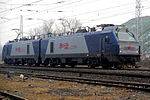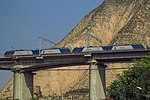China Railways HXD2
| HXD2 和谐2型电力机车 | |||||||||||||||||||||||||||||
|---|---|---|---|---|---|---|---|---|---|---|---|---|---|---|---|---|---|---|---|---|---|---|---|---|---|---|---|---|---|
 HXD2-0001 | |||||||||||||||||||||||||||||
| |||||||||||||||||||||||||||||
| |||||||||||||||||||||||||||||
| |||||||||||||||||||||||||||||
The HXD2 (Chinese: 和谐2型电力机车) is an electric locomotive and a series of related locomotive classes built by CNR Datong Electric Locomotive and Alstom. The locomotives designs are based on the Alstom Prima electric locomotives, and are a product of a cooperation agreement signed between the two companies in 2004.[11][12] All locomotives are intended for heavy freight work, including coal trains on the Datong Qinhuangdao line (Daqin Railway).
The original HXD2 locomotives are twin unit Bo′Bo′+Bo′Bo′ vehicles whereas the HXD2B and HXD2C versions are single unit Co′Co′ machines. At the time of their construction the HXD2 and HXD2B locomotives were amongst the most powerful locomotives in the world. The HXD2C is similarly specified to the HXD2B but of reduced power, and with increased localisation of components for lower cost.
The HXD2 was originally described as the DJ4-6000 class.[13]
Variants of the type were produced for railways other than China Railway: in 2010 Belarus state railways ordered a HXD2 twin unit locomotive variant (BCG-1); and in 2012 Shenhua Group also ordered twin section locomotives.
In 2012 CNR Datong announced a new sub-version of the HXD2 class, built using fully localised production; the HXD2-1000 series. In 2014 a new localised variant, in 2(Bo′Bo′) wheel arrangement and 9.6MW power, with axle load of 27tonnes (up to 30 tonnes on specialised line) was unveiled, designated HXD2F, and officially nicknamed 超级大力士.
Variants[edit]
HXD2[edit]
The locomotives are designed for heavy haul freight applications (up to 7,000 t or 6,900 long tons or 7,700 short tons train weights), and to be capable of multiple working of three locomotives. The design is also specified for temperatures down to −40 °C (−40 °F).[14]
The locomotive is ballasted to a 25 t (24.6 long tons; 27.6 short tons) axle load - a reduction to 23 t (22.6 long tons; 25.4 short tons) axle load with reduced starting tractive effort is optional.[7]
An (€350 million) order for 180 locomotives was placed (2005),[2][15] of which the initial 12 would be made in France, then 24 supplied for assembly, the remainder being produced in China.[1] The locomotives are used primarily for coal transportation,[16] specifically on the Datong - Qinhuangdao railway line.[1]
The first China built locomotive was produced May 23, 2007.[15]
In 2010 the locomotives began to be used on coal trains from Inner Mongolia.[17]
- Design
The main structural component is an integrated welded steel main bean and floor, with load bearing side sills. The side walls are of corrugated metal, and the roof of the locomotive is removable. The structure is designed for loads of 3,600 kN (810,000 lbf) in tension and 2,500 kN (560,000 lbf) in compression. The couplers are designed for up to 4,000 kN (900,000 lbf) force.[8]
The drivers cabins are designed for single driver operation. Driver facilities include a separate air-conditioned/heated area with refrigerator, cooking and washing facilities, and seating and beds.[8]
The locomotives use asynchronous AC electric motor technology, which drives the axles by a nose suspended drive. The bogies are of welded steel construction, with tractive forces transmitted by a low mounted drawbar. The electrical system consists of a transformers based on ABB Group products with 4 windings for electric traction power supply per transformer. Traction inverters are IGBT semiconductor device based, and of the Alstom ONIX type - each traction motor has a separate inverter/rectifier electrical power system. Electrical power for auxiliary devices is supplied via IGBT converters powered from the same intermediate DC power supply used to power the traction motors. Computer control and monitoring systems are from the Alstom AGATE[i] product range.[8]
HXD2-1000[edit]
In August 2012 CNR Datong announced the production of a new variant of its twin section, 8 axle, 10MW freight locomotive using domestically produced traction and control systems; the first unit was numbered HXD2-1001.[19] The two first units have corrugated sides, following ones have smooth sides.
HXD2-6000[edit]
From 2014 CNR Dalian delivered 40 HXD2 quite similar to series HXD2-1000.
HXD2-7000[edit]
From 2012 CNR Datong delivered 50 HXD2 quite similar to both first HXD2-1000 at the operator Shenhua Mining. Minor differences in cabin form.
-
HXD2-0021 at Chawu Railway Station
-
HXD2-0045 at Qinhuangdao Railway Station
-
HXD2-1076 (1000 Series)
-
HXD2 (1000 Series)
HXD2F[edit]
In April 2014 two indigenous two-unit (Bo′Bo′)-(Bo′Bo′) locomotives were unveiled by CNR Datong, nicknamed “超级大力士” (trans. 'Super hercules" or "Super strongman"). The locomotives had an axle load of 27–30 tonnes (27–30 long tons; 30–33 short tons) for higher tractive effort, with power output of 9.6 MW (12,900 hp).[4]
HXD2G[edit]
In November 2015 two indigenous two-unit (Bo′Bo′)-(Bo′Bo′) locomotives were unveiled by CNR Datong. The locomotives had an axle load of 18 tonnes (18 long tons; 20 short tons) for higher speed, with continuous power output of 11.2 MW (15,000 hp). It is designed for 200 km/h, but first used until 160 km/h.
Related orders[edit]
In October 2010 Belorusskaja Železnaja Doroga ordered 12 units of a derived variant of the HXD2 two-section locomotive,[20] to be designated BCG-1.[21]
In 2012 CNR Datong supplied the Chinese mining operation, Shenhua Group, with two 9.6 MW (12,900 hp), twin section, 120 kilometres per hour (75 mph), eight-axle locomotives, with traction equipment supplied by Bombardier. The locomotive type is derived from technology used in the 'Harmony' (HXD) series, and has been named "超级大力士",[22] (literal: "Super Strongman").
See also[edit]
- China Railways HXD2B
- China Railways HXD2C
- China Railways 8K, twin-unit locomotives produced by Alstom for China in the 1980s. see also 8K locomotive (Chinese language)
- Indian locomotive class WAG-12, Indian twin unit locomotives also developed by Alstom using the Prima model.
- List of locomotives in China
Notes[edit]
References[edit]
- ^ a b c "Alstom shares heavy haul build with Datong". www.railwaygazette.com. Railway Gazette International. 1 March 2006. European electrics.
- ^ a b c d e f g "China's rail revolution" (PDF), www05.abb.com, ABB Group, Growth in freight transportation, p.21
- ^ Sources:
- "中国北车和谐2C型电力机车中标铁道部采购项目", business.sohu.com (in Chinese), 12 July 2010
- "中国北车"和谐2C型"电力机车中标铁道部采购项目", news.hexun.com (in Chinese), 12 July 2010, archived from the original on 1 May 2014, retrieved 8 February 2012
- ^ a b c Sources:
- 中国铁路新生代“超级大力士”在中国北车诞生, www.chinacnr.com (in Chinese), 10 April 2014, archived from the original on 2 May 2014, retrieved 30 April 2014
- 新民晚报专版:赵明元:亲历中国迈向铁路重载强国, www.chinacnr.com (in Chinese), archived from the original on 2014-05-02, retrieved 2014-04-30
- 赵明元:亲历中国迈向铁路重载强国 (in Chinese), Xinmin Evening News (xinmin.cn), 13 April 2014, archived from the original on 25 April 2014, retrieved 30 April 2014
- ^ a b Jean-Marc Allenbach, "BoBo+BoBo CR HXD2 (Spec Sheet)" (PDF), documents.epfl.ch (in French)
- ^ Jean-Marc Allenbach, "CoCo CR HXD2b (Spec Sheet)" (PDF), documents.epfl.ch (in French)
- ^ a b "HXD2型大功率交流传动电力机车". www.chinacnr.com (in Chinese). Archived from the original on 4 October 2011. Retrieved 6 February 2011.
- ^ a b c d "HXD2型电力机车". dt.chinacnr.com (in Chinese). Archived from the original on 8 July 2011. Retrieved 6 February 2011.
- ^ "HXD2B型大功率交流传动电力机车". www.chinacnr.com (in Chinese). Archived from the original on 2011-10-04. Retrieved 2011-02-06.
- ^ "HXD2C型大功率交流传动电力机车". www.chinacnr.com (in Chinese). Archived from the original on 4 October 2011. Retrieved 6 February 2011.
- ^ "Alstom ruling awaited". www.railwaygazette.com. Railway Gazette International. 1 July 2004.
Alstom announced on June 11 that it had signed an agreement to co-operate in the manufacture of locomotives with CNR Datong Electric Locomotive Co in China..
- ^ Murray Hughes (1 March 2006). "Tide of technology pours into China". www.railwaygazette.com. Railway Gazette International. European electrics. Archived from the original on 17 June 2011. Retrieved 6 February 2011.
- ^ "和谐号CRH系列与和谐HX系列" (in Chinese). 10 July 2009. 「和諧」型系列机车車款如下:. Retrieved 6 February 2011.
- ^ "HXD2型电力机车". www.dt.chinacnr.com (in Chinese). Archived from the original on 8 July 2011. Retrieved 6 February 2011.
- ^ a b 杨雄京 (Jing Yang Xiong) (31 May 2007). "9,600 kW (12,900 hp) electric locomotive rolled out". Archived from the original on 4 October 2011. Retrieved 6 February 2011.
- ^ 北车造和谐2型电力机车通过2万吨重载牵引试验. www.gov.cn (in Chinese). 21 January 2008.
- ^ 北车制造和谐2型机车助力蒙煤外运传捷报. www.dtloco.com (in Chinese). 30 December 2010. Archived from the original on 24 July 2011. Retrieved 6 February 2011.
- ^ Christoph Loch (2003). Industrial excellence: management quality in manufacturing. Springer. p. 64. ISBN 9783540002543.
- ^ Sources:
- "中国北车创造世界铁路"重载之王"", www.chinacnr.com, 27 August 2012, archived from the original on 4 March 2016, retrieved 6 September 2012
- "CNR Datong unveils 10 MW locomotive designed to cross China", www.railwaygazette.com, 6 September 2012
- ^ "World rolling stock market December 2010". www.railwaygazette.com. Railway Gazette International. 14 December 2010. Belarus.
- ^ "China Northern signs European locomotive order". www.railwaygazette.com. Railway Gazette International. 27 April 2010. Archived from the original on 17 June 2011. Retrieved 6 February 2011.
- ^ Sources:
- "CNR Datong Electric Locomotive Co., Ltd. delivered high-power electric locomotive with AC transmission to Shenhua Group", www.chinacnr.com, 15 June 2012, archived from the original on 4 March 2016, retrieved 26 June 2012
- "PROJECTS IN CHINA : Propulsion and controls", cn.bombardier.com, retrieved 26 June 2012,
Propulsion equipment and control system including spare parts for two 9.6MW double Bo-Bo electric locomotives of Datong Electric Locomotive Co., Ltd. to China Shenhua Group (August 2011)
- 李圣 (4 June 2012), 中国北车为神华集团特制火车头"超级大力士"可促运能提升2倍, www.chinacnr.com (in Chinese), archived from the original on 4 March 2016, retrieved 26 June 2012




